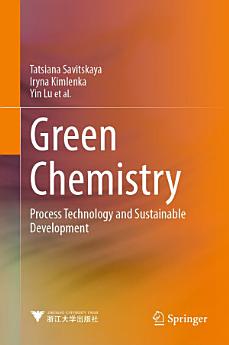આ ઇ-પુસ્તક વિશે
લેખક વિશે
Tatsiana Savitskaya, the founder of the Green Chemistry Course at the Belarusian State University, the author of the first monography in Belarus on edible films and coatings, more than 350 papers, 30 inventions and patents has created a new direction in the physico-chemistry of plant polymers for the development of composites based on cellulose, lignin, starch, chitin by green technologies.
Iryna Kimlenka, an Associate Professor of the Faculty of Chemistry, the co-author and lecturer of the course "Introduction to green chemistry” at BSU. She has participated in the different international and national projects focused on the environmental monitoring and ecological problems solving. The author of more than 100 papers including 3 textbooks.
Yin Lu, a director of the Chinese Society of Environmental Sciences, majors in environmental science in Zhejiang Shuren Unviersity of China. She has presided over 20 projects at the national, provincial and ministerial levels. More than 88 representative papers, three monographs and more than 20 invention patents have been published.
Dzmitry Hrynshpan, a head of the Laboratory of the Research Institute for Physical and Chemical Problems of the Belarusian State University, the developer of green technologies for the production of hydrocellulose fibers by zero waste process, composite biofuel based on the hydrolytic lignin and oil products waste. One monograph, more than 450 papers, 80 inventions and patents.
Sarkisov Valentin is a postgraduate of the BSU, master student of the National Academy of Sciences of Belarus. He is currently working at the Institute of General and Inorganic Chemistry of National Academy as junior researcher. His research interests include heterogeneous Fenton catalysts, advanced oxidation processes and adsorbents for water purification.
Jie Yu is an associate professor at the College of Biology and Environmental Engineering of Zhejiang Shuren University. His research field is mainly focused on the organic based catalytic reactions. He has presided or participated in five projects at the provincial or ministerial levels. More than ten representative papers have been published.
Nabo Sun, majors in Organic chemistry in Zhejiang Shuren Unviersity of China. She is the training object of young and middle-aged subject leaders in Colleges and Universities of Zhejiang Province, She has presided 3 projects at the national, provincial and ministerial levels. More than 20 representative papers and 6 invention patents have been published.
Shilei Wang received his PhD from Zhejiang University of Technology in 2015. He subsequently worked as a lecturer at the College of Biology and Environmental Engineering,Zhejiang Shuren University. His research mainly focuses on natural products from microorganism and plants of traditional Chinese medicine. He has presided or participated in four projects at the national or provincial and ministerial levels.More than ten representative papers and one invention patents have been published.
Wei Ke, a professional lecturer of bioengineering and a member of bioinformatics society. She has presided over the projects of Zhejiang Provincial Department of education, 2 horizontal projects, participated in a number of National Youth Science Foundation projects and Zhejiang provincial public welfare projects, and published 15 papers, including 5 SCI papers.
Li Wang is an associate professor at at the College of Biology and Environmental Engineering,Zhejiang Shuren University. She has been engaged in the pollutants control, especially in the field of air pollution control and water pollution. The courses she teaches include air pollution control and the related experiments, environmental law, etc. More than 10 representative papers, 4 invention patents have been published.





